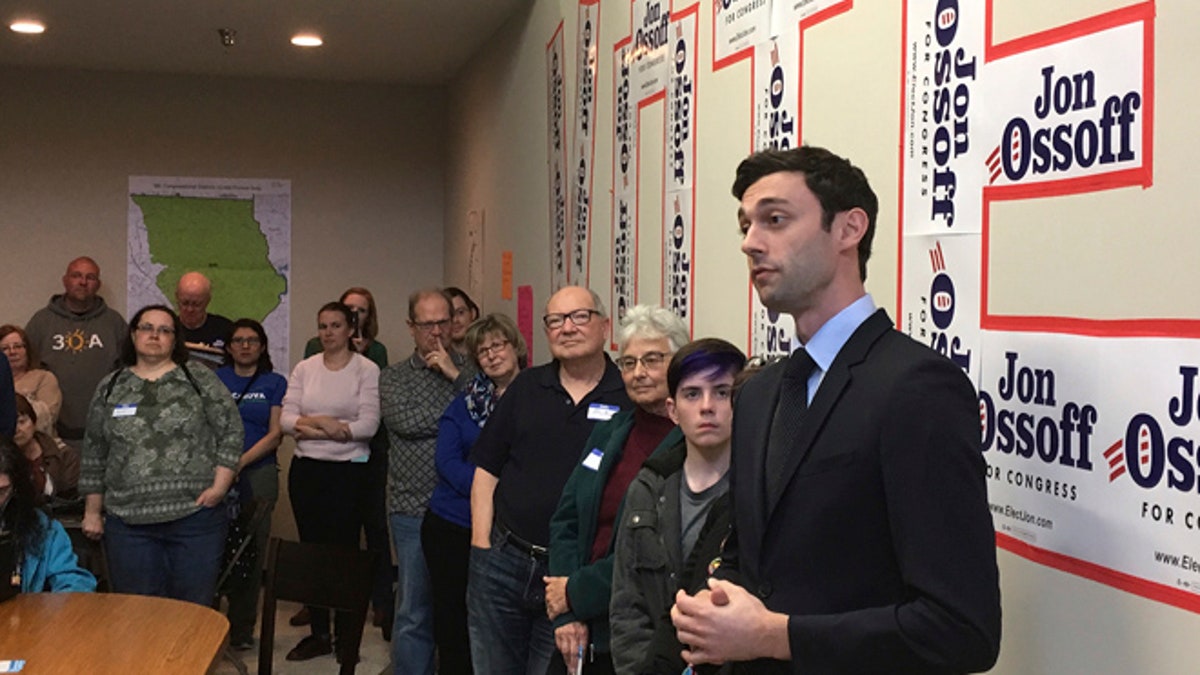
FILE: March 11, 2017: Jon Ossoff, the Democratic candidate in this year's Georgia special House election, at his Cobb County campaign office. (AP)
After painful November 2016 losses, Washington Democrats still appear committed to devoting resources to strongholds like California, instead of responding to party pleas to put time and money into Middle America to reconnect with disaffected voters.
The contrast came into full view when the Democratic Congressional Campaign Committee earlier this month started moving senior staffers to deep-blue California, then provided essentially no help to its candidate in the Kansas special election, who on Tuesday nearly pulled off a huge upset.
Washington Democrats hailed candidate James Thompson’s narrow loss as a moral victory, considering Republicans have held the seat since 1995.
But Thompson made clear that the DCCC and the Democrat National Committee could have done more, considering Washington Republicans including President Trump, Vice President Pence and Texas Sen. Ted Cruz invested time and money to save the seat.
“The DCCC and the DNC need to be doing a 50-state strategy,” said Thompson, after coming within 6 percentage points of winning Kansas GOP Rep. Mike Pompeo’s open House seat. (Pompeo won reelection there last year with roughly 60 percent of the vote before becoming the CIA director in January.)
GOPS WIN IN CLOSE SPECIAL ELECTION IN KANSAS
Thompson also pointed out that his campaign was largely financed by individual, small-dollar donations, saying 99 percent of the money came through average-$20 contributions.
The state Democrat party disputes a report that it gave Thompson just $3,000 late in the race but has failed to provide documentation showing the group in fact backed the first-time candidate’s campaign from the start.
The DNC contributed no last-minute money to counter the GOP infusion, with newly-installed Chairmen Tom Perez telling The Washington Post: “There are thousands of elections every year, though. Can we invest in all of them? That would require a major increase in funds.”
DNC Communications Director Xochtil Hinojosa told Fox News on Wednesday that the outcome of the Kansas race -- in a district Trump won in November by 27 percentage points -- proves voters’ “resounding frustration” with the president’s agenda and that Washington Democrats are “committed to organizing in every zip code.”
Meanwhile, the DCCC, which declined to comment for this story, is already sending staffers to Southern California to establish a base camp for 2018 House races in the state and in Nevada, Oregon and Washington.
“Moving out West is one of the improvements that we’re making at the DCCC in order to maximize gains in the midterms,” says group Chairman Rep. Ben Ray Luján.
The New Mexico congressman also vowed that he and fellow Democrats are “on offense across the map -- including in districts that have not seen a serious challenge in a long time.”
To be sure, the DCCC has sent dozens of paid staffers and hundreds of volunteers to Georgia for the special election Tuesday for the open seat of former GOP Rep. Tom Price, in a district Trump barely defeated Democrat Hillary Clinton. (Democratic candidate Jon Ossoff has raised more than $8 million in that race.)
But whether the plan is enough to satisfy rank-and-file Democrats after November 2016 remains to be seen.
Before last year, Republicans had already controlled both chambers of Congress as well as the majority of state houses and governors’ offices.
And losses in Democratic strongholds like Pennsylvania, Wisconsin and Florida in 2016 that led to Trump’s upset victory over Clinton -- and nixed the party’s chances to retake the Senate -- only reinforced the notion that the Midwestern, blue collar vote has been neglected.
“We have to talk to those people who take a shower after work, not those who just take a shower before work,” Ohio Democratic Rep. Tim Ryan said after the losses and amid his subsequent, failed effort to replace California Democratic Rep. Nancy Pelosi as House minority leader.
He also joined fellow party members in saying Democratic leaders had become too focus on liberal bastions like California, New York and neighbor East Coast states.
Despite Democrats last year winning a handful of House seats, Republicans will still have a daunting, roughly 44-seat majority going into the midterms and a 52-48 seat edge in the Senate.
In California, Democrats are targeting seven incumbent House Republicans -- including high-profile Reps. Dana Rohrabacher and Darrell Issa and three others in Southern California.
Ben Tulchin, a San Francisco-based Democratic pollster and Vermont Sen. Bernie Sanders’ pollster in the 2016 Democratic primaries -- supports the party’s California strategy.
He says such grassroots efforts in places like Los Angeles and Orange counties make sense because voter-registration drives can reach a large number of unregistered Latinos, Asian-Americans and others who frequently vote Democrat.
“There’s an untapped pool of Democratic voters that just doesn’t exist in place like Iowa,” he said.
Tulchin also argued that reaching voters by TV in the greater-Los Angeles market is too expensive and that voters in largely-conservative Orange County, particularly along the coast, are becoming more socially liberal or at least more moderate.
“They’re almost all pro-environment,” Tulchin said.




